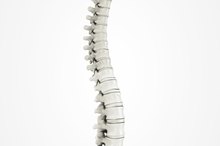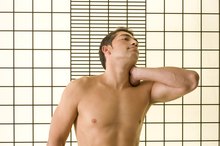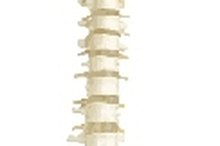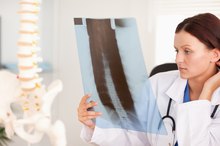The End Stages of Degenerative Disc Disease
End stage or advanced degenerative disc disease occurs when the intervertebral disc degenerates and the disc space collapses. This can result in herniation of the inner disc material through the disc wall. There also can be visible changes on the bony portion of the adjacent vertebrae as detected by MRI or CT scan. The resultant pressure of the disc material on neurological tissues is the source of pain and neurological symptoms.
Degenerative Disc Dynamics
Degenerative disc disease is a general phrase that describes the alterations which occur as the intervertebral disc ages. According to the Mayfield Clinic, the disc becomes less flexible and cannot effectively cushion the forces of the adjacent vertebral bones. The primary reason the disc loses its mechanical strength is due to water loss or dehydration. It causes the disc to shrink and puts more stress on the disc’s outer wall. That stress creates small rips in the disc wall. When this occurs, the softer inner disc material can protrude through the rip, or herniate. When the herniated material pushes on the spinal cord or spinal nerves it can cause severe pain and other symptoms. Other features of advanced degenerative disc disease occur when the disc space becomes so narrow that the vertebral bones rub together. This produces abnormal bone growth on the vertebrae. These combined effects result in narrowing of the spinal canal, called spinal stenosis. Spinal stenosis can cause compression the spinal cord and spinal nerves, leading to even more pain and dysfunction.
- Degenerative disc disease is a general phrase that describes the alterations which occur as the intervertebral disc ages.
- According to the Mayfield Clinic, the disc becomes less flexible and cannot effectively cushion the forces of the adjacent vertebral bones.
Advanced Symptoms
Thoracic Spine Degeneration Symptoms
Learn More
The symptoms of advanced degenerative disc disease depend largely on which spinal level the pathology occurs and the amount of herniation or stenosis involved, according to the University of California San Diego Center for Functional MRI. Generally speaking, the most significant feature of the condition is pain. This pain is usually continuous and can radiate into the back, hips and legs. Flare-ups of the pain often occur, and when the spine is twisted or bent the pain frequently gets worse. Severe cases can result in more pronounced symptoms. Sensory dysfunctions, known as parasthesias may occur in the back, arms and legs, and may be so severe as to cause paralysis on one side of the body. Occasionally, weakness in one or both legs may occur, and walking behavior may be affected. Bladder and bowel function may also be disturbed, and there may be paralysis of part of the diaphragm muscles.
- The symptoms of advanced degenerative disc disease depend largely on which spinal level the pathology occurs and the amount of herniation or stenosis involved, according to the University of California San Diego Center for Functional MRI.
- Sensory dysfunctions, known as parasthesias may occur in the back, arms and legs, and may be so severe as to cause paralysis on one side of the body.
Treatments
In general, nonsurgical treatments, also called conservative therapies are the first attempt to relieve symptoms of degenerative disc disease. According to the Mayfield Clinic, these include using nonsteroidal anti-inflammatory medicines, pain relievers and muscle relaxers. Corticosteroid drugs can also be injected directly into the spinal column to manage the pain. Rest, back braces, physical therapy, exercise, and chiropractic medicine are also frequently used. When such treatments fail or if the symptoms get worse, surgery is usually recommended. Surgery involves removing the degenerated disc in its entirety or the disc material that has herniated onto the neural tissues. According to MDGuidelines, removing the disc, called discectomy may result in interbody spinal fusion. This means the intervertebral space receives grafted bone material to encourage the vertebrae to grow together. Often, the bones are stabilized with metal hardware so the vertebrae do not move while they fuse.
- In general, nonsurgical treatments, also called conservative therapies are the first attempt to relieve symptoms of degenerative disc disease.
- According to MDGuidelines, removing the disc, called discectomy may result in interbody spinal fusion.
Related Articles
References
- UCLA Comprehensive Spine Center: Degenerative Disc Disease
- MDGuidelines: Displacement, Cervical Intervertebral Disc Without Myelopathy
- University of California San Diego Center for Functional MRI
- Schoenfeld AJ, Weiner BK. Treatment of lumbar disc herniation: Evidence-based practice. Int J Gen Med. 2010;3:209-14. doi:10.2147/ijgm.s12270
- Jeong DK, Choi HH, Kang JI, Choi H. Effect of lumbar stabilization exercise on disc herniation index, sacral angle, and functional improvement in patients with lumbar disc herniation. J Phys Ther Sci. 2017;29(12):2121-2125. doi:10.1589/jpts.29.2121
- American Association of Neurological Surgeons. Herniated disc.
- Goldberg H, Firtch W, Tyburski M, et al. Oral steroids for acute radiculopathy due to a herniated lumbar disk: a randomized clinical trial. JAMA. 2015;313(19):1915-23. doi:10.1001/jama.2015.4468
- Qaseem A, Wilt TJ, Mclean RM, Forciea MA. Noninvasive treatments for acute, subacute, and chronic low back pain: a clinical practice guideline from the American College of Physicians. Ann Intern Med. 2017;166(7):514-530. doi:10.7326/M16-2367
- Bednar DA. Cauda equina syndrome from lumbar disc herniation. CMAJ. 2016;188(4):284. doi:10.1503/cmaj.150206
- Boden, SD, et al. Abnormal magnetic-resonance scans of the lumbar spine in asymptomatic subjects. A prospective investigation. J Bone Joint Surg Am. 1990 Mar;72(3):403-8.
- Mathews HH and Long BH "Minimally Invasive Techniques for the Treatment of Intervertebral Disk Herniation" J. Am. Acad. Ortho. Surg., March/April 2002; 10: 80 - 85.
Resources
Writer Bio
Dr. Christian Walker began writing professionally in 1982. He has published in the fields of surgery, neurology, rehabilitation and orthopedics, with work appearing in various journals, including the "Journal of the American Osteopathic Association" and "European Neurological Society." Walker holds a Doctor of Philosophy in medical physiology from the University of Medicine and Dentistry of New Jersey.







